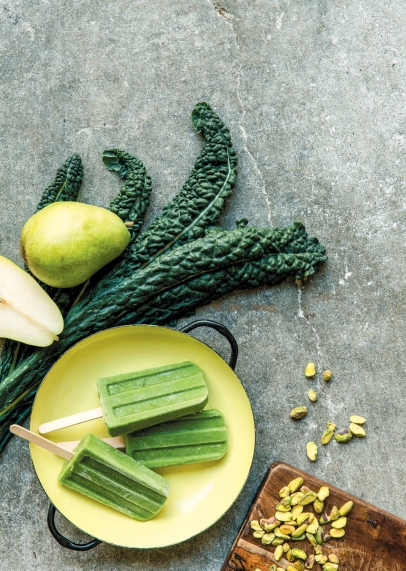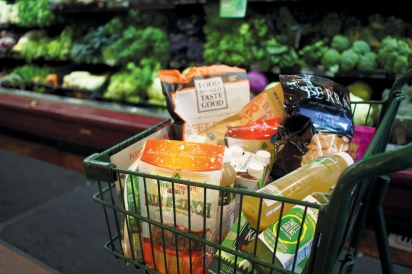The Rise of Convenience Vegetables
Would Hippocrates Approve of Veggie Popsicles?
“Eat your vegetables!”
It’s been the battle cry of mothers for generations. But ever since Hippocrates declared “let food be thy medicine and medicine be thy food,” doctors have been begging adults to do the same. Modern documentarians and Fairfax hippies alike have laid out the case for a plant-based diet. Weight loss gurus, fitness phenoms, nutritionists and even couch potatoes all know too well that vegetables are good for you. Why then, don’t we eat more of them?
This question has spawned countless business opportunities—even here in Marin, where eating our vegetables couldn’t be easier or more convenient. A walk through any of our grocery stores yields countless powdered greens mixes, bags of kale chips, racks of vegetable-based energy bars, endless bottles of fresh-pressed juice with vegetable combos. You even can get veggie popsicles for dessert. Is this the future of eating vegetables?
Just 200 years ago people had good reasons not to eat vegetables: They were tough to store. In 1804, Emperor Napoleon Bonaparte, wanting to keep his armies fed, offered a cash prize to whoever could develop a reliable way to preserve food. Nicolas Appert, a young chef from the Champagne region of France, won the prize by sealing food airtight in Champagne bottles with a mixture of cheese and lime then heating it—an early form of canning.
By 1806 one of the world’s first food critics, Alexandre Balthazar Laurent Grimod de la Reynière, noted that Appert’s canned fresh peas were “green, tender and more flavorful than those eaten at the height of the season.” Appert’s process, which hasn’t changed significantly from that day, is well documented in his 1811 book The Art of Preserving, for Several Years, all Animal and Vegetable Substances (which amazingly enough you can still buy on Amazon! Amazon.com/Preserving-Animal-Vegetable-Substances-Several/dp/1437069959).
Fifty years later, Louis Pasteur discovered the reason Appert’s canning was effective: because it slowed the growth of microorganisms that cause food spoilage.
But these days, it’s not about preservation. Here in Northern California, we have arguably the greatest access to top-quality year-round produce of anywhere in the world. And while we probably consume more vegetables than people in other areas of the country—Californians rank the highest, with 13% of us eating the recommended amount of veggies, compared to a low of 5.5% in Mississippi—we still don’t get nearly enough. According to USDA guidelines, adults should consume two to three cups of vegetables per day.
An extensive study of the eating habits of 65,226 people was conducted by University College in London between 2001 and 2013. The study found that eating seven or more servings of vegetables a day reduces the specific risks of death by cancer and heart disease by 25% and 31%, respectively. The research also showed that vegetables have significantly higher health benefits than fruit. Yet, we still don’t eat them. Vegetables are unique in that way. No studies show that people need to eat more meat, ice cream, pancakes, pistachios, strawberries or anything else for that matter, but we do.
What is it? Do vegetables in their natural state just not taste good enough? Are they inconvenient to eat? The recent boom in pressed vegetable juice establishments here in Marin seem to indicate the answers are “yes” and “yes.”
Melora Johnson started her Mill Valley store, Juice Girl, in 2014. Initially she was just doing juice because she saw a business opportunity. “I juiced for myself and it took me so long I figured I might as well start doing it for other people, as well. I knew it was a craze, but I still marveled that people didn’t just eat their veggies.
Since then, she says her business has evolved from juicing. “Despite our name we are really about food. I see juice as a way for people who don’t normally get enough vegetables to get them. We try to make vegetables appealing to them in a different form. So if a person doesn’t want a salad they can have a green juice. But my preference is that they have a salad, so we offer that as well.”
Johnson thinks people find drinking juice fun. “Realistically, the people who come in here probably eat fairly well, but need help with the convenience factor. My typical client maybe doesn’t have time to eat a salad or cook something fabulous so they will sit down and drink a juice. It’s easy and it makes them feel good.”
Chyna Honey, owner of Café del Soul with locations in both Mill Valley and San Rafael, has been serving healthy food to Marinites for 12 years at her restaurants. She thinks the problem of vegetable consumption goes much deeper than convenience. “It relates to how we learned to value food as a child.”
Honey contends that at a very young age we learned that sugar is good—the reward for good behavior. “The reward never comes in the form of carrot juice.” She believes that even though we know vegetables are good for us, deep down we believe they are somehow a punishment thanks to admonishments like “you can’t have dessert until you eat your vegetables.” Consequently, as we get older and start to realize the value of better nutrition, there is still that little bit in the back of our minds that reminds us, “if I’m having a bad day, I’m not thinking about kale, I’m thinking about chocolate.”
She goes on to note that ultimately people seek comfort more than they seek feeling better, and we don’t do a very good job of differentiating between those two things. In fact, she notes, there’s a whole culinary experience of generally bad-for-you food called “comfort food.”
“Why wouldn’t healthy food be considered comfort food?”
Dr. Dean Ornish would certainly agree. Ornish is the president and founder of the nonprofit Preventive Medicine Research Institute in Sausalito, as well as clinical professor of medicine at UCSF and is one of the best-known advocates of healthy diets, particularly vegetarianism. He has been a physician consultant to luminaries such as former President Bill Clinton since 1993.
Ornish contends people are, in fact, eating more vegetables these days because there’s a growing awareness that it makes a difference. “There are literally hundreds of thousands of protective substances in vegetables and fruits … with phytochemicals, phytoflavinoids, carotenoids, retinoids, chemicals that seem to have anti-cancer, anti-heart disease, even anti-aging properties.”
He does acknowledge there is a large problem in the way they are framed. “If you say ‘eat your vegetables so something bad doesn’t happen to you 20 years from now,’ that’s hard for people to get motivated by. But when people understand that when you eat a lot of fruits and vegetables you feel better, you look better, you have better sex, you don’t age as quickly, your skin looks younger, you sleep better and more—it’s not just about fear of dying or fear of something bad happening, it’s the joy of living that really motivates people. When people realize that these underlying biological mechanisms are so dynamic and how quickly you can feel better when you eat healthy or how quickly you can feed badly when you don’t, then it reframes the reason for those choices from fear to joy and pleasure. And in the wine country, that’s ultimately the ethos. It’s all about feeling and looking good and having more pleasure.”
Ornish is a fan of the convenient ways of consuming vegetables, but says it’s best to get your vegetables in a form as close to nature as possible. “While it’s clearly better to eat vegetable chips than a cheeseburger or regular potato chips, the problem comes when people think that it’s just as good to eat vegetable chips as it is to eat steamed broccoli. Of course it’s not. It’s a better choice, but it’s not necessarily a good choice.”
He explains when you turn something into a chip it becomes a refined carbohydrate, causing its glycemic index to go up considerably. It gets absorbed very quickly when you eat it and causes your blood sugar to spike. “Whatever the intrinsic benefits of the ingredients are, they are often offset by the way they are delivered.” On the other hand, when you get those same vegetables in nature they have a lot of fiber, slowing the absorption as well as reducing rapid swings in your blood sugar.
Equally important and less discussed, according to Ornish, is that there is a life force in vegetables. Ornish points to the recent movie The Martian, where Matt Damon needs to start growing vegetables for himself. He takes some potatoes that were in a freezer, cuts them in half, and they grow. You can’t do that with processed vegetables. Ornish says that life force is harder to measure than how many vitamins are in there “but it’s real. In addition to those nutrients and the way they are absorbed, there’s a vital energy that you miss when you eat something that is processed as opposed to in its natural form.”
As for the future of vegetables, Ornish says we’re on a wave that hasn’t even begun to crest yet. “The fastest-growing trend in food these days is the pre-prepped, convenient healthy meals using real food like what Mark Bittman’s Purple Carrot is doing.” He believes as the population ages and as more research comes out that shows drugs and surgery don’t work nearly as well in many cases as people thought, that a healthy diet will become more and more common.
Ornish encourages people to go to his free website, Ornish.com, that shows people how to make vegetables taste good. “There are cooking videos, recipes, menus, online communities, guided meditations and so on. It’s all there. Like anything, you can make vegetables taste good or you can make them taste bad; you can make meat taste good or taste bad … it’s how you prepare it. And there are so many world-class chefs in this area that people should reassess how they feel about vegetables by going to a restaurant that knows how to cook them properly.”
Juice Girl’s Johnson agrees. While her foods provide a convenience, she doesn’t view her juicing as a step toward a dystopian future where foods are consumed in formulated bottles, pills, powders, chips and packets to give you exactly what you need. In fact, she sees it as the opposite—as kind of a “gateway drug” to eating whole foods again.
“People are swinging back to eating whole foods. The high school kids come in at lunch and buy an avocado on whole-grain toast. We sell hundreds of those! The juicing just got them started.”







